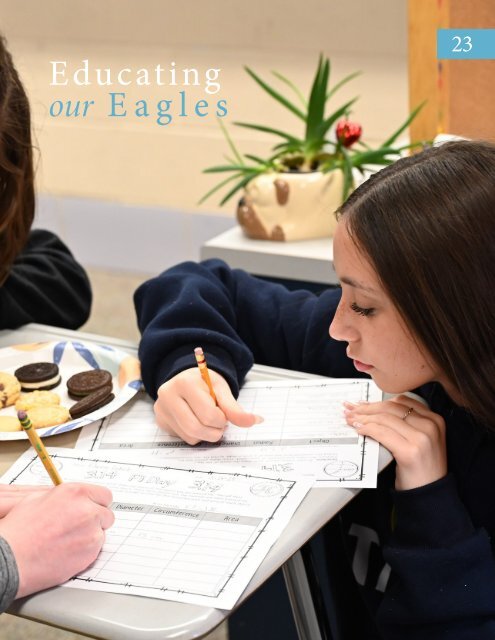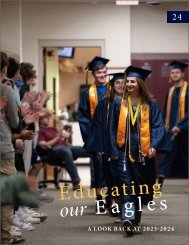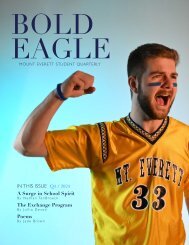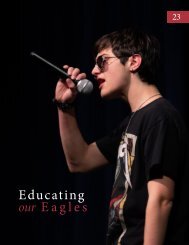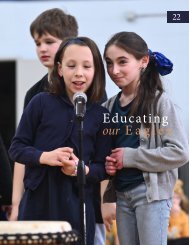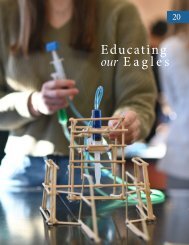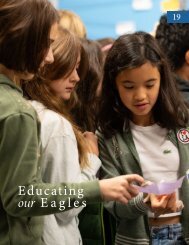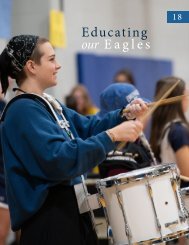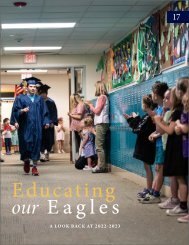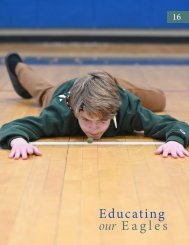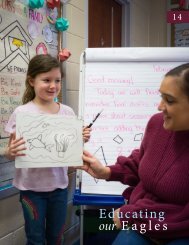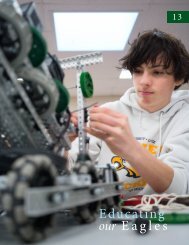Educating Our Eagles - Issue 24
Create successful ePaper yourself
Turn your PDF publications into a flip-book with our unique Google optimized e-Paper software.
<strong>Educating</strong><br />
our <strong>Eagles</strong><br />
23
CONTENTS<br />
4<br />
Introduction - Curriculum Director, Julie Dolan<br />
6<br />
Third Grade - Let’s Go Fly A Kite – Madeline Caruso<br />
8<br />
Fourth Grade - Trip to The Clark – Jane Schur<br />
10<br />
Second Grade - Basic Shape Landscapes – Todd Titone<br />
12<br />
Second Grade - Landform Dinosaurs – Morgyn Gasperini<br />
14<br />
Tenth Grade - Trigonometry and Triangles – Tim Schwartz<br />
15<br />
Ninth Grade - Public Speaking – Christine McEvoy<br />
16<br />
Seventh Grade - Comparing Two Populations– Kristy Cavanaugh<br />
18<br />
High School - Art Showcase – Stephanie Graham<br />
Cover: Middle School student celebrate Pi Day by measuring cookies.<br />
Right: Elementary students participate in SBRSD's Math Night.<br />
EDUCATING OUR EAGLES<br />
2
EDUCATING OUR EAGLES<br />
3
INTRODUCTION<br />
From SBRSD’s Director of Curriculum<br />
and Instruction, Julie Dolan<br />
Happy Spring! It is so nice to have some sunny warm spring weather.<br />
This is the time of year when we start to have many special events<br />
being put on the calendar so, please keep your eye out for upcoming<br />
happenings.<br />
I would like to take a moment to highlight the Family Math Night<br />
held last month at Undermountain. This event was huge with over<br />
150 participants. The goals of the evening were to educate families on<br />
conceptual math practices, support them with ideas on how they can<br />
work with their student at home, and of course have some fun!<br />
I would like to thank Jane Schur, our Math Leader, for organizing<br />
this event and the following teachers for supporting her and<br />
working that night:<br />
Kim Bleau<br />
Marian Dodds<br />
Ashley Lotz<br />
Christina Carlson<br />
Liz O’Donnell<br />
Ashley Barrett<br />
Jaimi-Lyn Schieb<br />
Lindsey Fogle<br />
Jodi Hutchinson<br />
Annie Alquist<br />
It is important that we gather and celebrate students and their work.<br />
We hope these types of evenings help them connect what they do in<br />
school to their lives and instill a joy of learning.<br />
I am attaching a link to a survey to receive feedback on the family<br />
Math Night for those that attended; we would really appreciate<br />
your feedback.<br />
https://www.surveymonkey.com/r/F9PXTSF<br />
We look forward to offering more family/community events where we<br />
can learn, grow, and play together!<br />
Right: Third grader listens in class while his reading buddy joins<br />
him on his desk during Read Across America Week.<br />
EDUCATING OUR EAGLES<br />
4
5
ELEMENTARY SCHOOL:<br />
Let’s Go Fly a Kite!<br />
The 3rd grade Chorus is getting ready for their spring concert! They watched a fun clip<br />
from Mary Poppins to learn a new song called “Let's Go Fly a Kite.” To prepare for singing<br />
it, they reviewed some important musical ideas like tempo (how fast or slow the music<br />
goes), major/minor (happy or sad sounding), dynamics (how loud or soft to sing), and mood<br />
(the feeling the music creates).<br />
Students were instructed to think about the following questions as they listened:<br />
What is this song about?<br />
What is the tempo of this song?<br />
Is this song in major or minor?<br />
Is it mostly loud or quiet?<br />
What is the mood of this song? How do you know?<br />
After listening to the song, the class had a discussion about these questions, and students were<br />
offered context about where this song appears in the story of Mary Poppins. As they started to<br />
learn the song on their own, students were asked to think about mood as they sang and learned<br />
about how to show certain emotions in their voices.<br />
As a result of instruction, students will be able to:<br />
• perform the first verse of the song “Let’s Go Fly a Kite” from Mary Poppins.<br />
• identify the mood of a piece of music based on tempo, dynamics, tonality, and lyrics.<br />
Observations:<br />
Students seemed very excited about Mary Poppins! When asked how many of them had seen the<br />
movie, almost all of them raised their hands. We talked about Mr. Banks and how he started out<br />
serious and loosened up by the end of the movie. Students were able to identify that the music was<br />
probably in major based on how it sounded, that the tempo was around walking speed, and that the<br />
mood was generally happy. Some students had physical reactions to the song, dancing in their seats<br />
with a smile on their faces. Giving context of the song was helpful to get them engaged in singing, and<br />
they really enjoyed watching the video.<br />
MA Standards<br />
3-4.M.P.05: Develop and refine artistic techniques and work for presentation. Sing and play musical<br />
canons, rounds, and music in at least two parts.<br />
3-4.M.R.07: Perceive and analyze artistic work. Analyze how expressive qualities (e.g. tempo,<br />
dynamics, timbre) are used to demonstrate a composer’s musical intent.<br />
https://www.doe.mass.edu/frameworks/current.html<br />
EDUCATING OUR EAGLES<br />
6
EDUCATING OUR EAGLES<br />
7
ELEMENTARY SCHOOL:<br />
Trip to The Clark<br />
Fourth-grade students traveled to The Clark on March 28th. This was a culminating event<br />
following a month-long study of artists in writing. Students were able to see artwork from<br />
Monet, Degas, Renoir, and Homer. The day was fun and inspiring. A big shout-out to the<br />
UME PTO for helping us get there!<br />
As a result of instruction students will be able to:<br />
• discuss and notice different artist’s style.<br />
• observe art in various mediums.<br />
• learn stories behind famous art work.<br />
• connect artists they studied with their work.<br />
Observations<br />
Students were very engaged and noticed many details within the pictures they saw. Students<br />
were able to share how different artwork made them feel. They had discussions about how art<br />
tells a story and can draw out emotions, just like in written work.<br />
MA Standards:<br />
Art - 3-4 v.cr.01, 3-4 v.co.11<br />
EDUCATING OUR EAGLES<br />
8
EDUCATING OUR EAGLES<br />
9
ELEMENTARY SCHOOL:<br />
Exploring Landscapes Using Basic Shapes<br />
This second grade art lesson began with an introduction to various drawing techniques<br />
using basic shapes. Students then embarked on creating vibrant zoo landscapes, where<br />
they practiced sketching a variety of animals such as birds, frogs, turtles, horses, and<br />
lions. Using pencils and colored markers, they identified and incorporated fundamental shapes<br />
to construct their artistic creations. Peer assessment allowed students to provide constructive<br />
feedback on each other's animal drawings. Additionally, students engaged in self-assessment<br />
by evaluating their own work based on the successful use of shapes. To solidify their learning,<br />
the project concluded with group presentations, where students eloquently explained their zoo<br />
landscapes and the specific shapes they employed.<br />
As a result of instruction, students will be able to:<br />
• learn about the five basic shapes (circle, square, triangle, rectangle, and oval)<br />
and their characteristics.<br />
• create a bird using a combination of basic shapes and enhance it with oil pastels.<br />
• construct frogs and turtles by combining and manipulating basic shapes.<br />
• utilize basic shapes to compose and color horses in a landscape scene.<br />
• illustrate a Landscape Zoo by incorporating basic shapes effectively and innovative.<br />
Observations:<br />
I witnessed students trying their best to use different shapes like circles, squares, and triangles<br />
in their animal drawings. Student work showed colors that were very bright, making their<br />
zoo landscape drawing look very vibrant. Students did a great job discussing their animal<br />
drawings during the group presentation.<br />
MA Standards:<br />
Demonstrate an understanding of visual art elements and principles.<br />
Create art using various tools, media, and processes, safe practices, and proper care of<br />
materials.<br />
Communicate an idea or emotion through visual art.<br />
Analyze and interpret the meanings of artwork.<br />
Make connections between visual art and other disciplines.<br />
EDUCATING OUR EAGLES<br />
10
EDUCATING OUR EAGLES<br />
11
ELEMENTARY SCHOOL:<br />
Landform Dinosaurs<br />
After spending a few weeks introducing the different kinds of water and land<br />
formations, making reference books, and various other lessons, the students were<br />
tasked with a unique, abstract way to practice their skills. The students were given<br />
a paper with the outline of a dinosaur and asked to find and label eight different landforms<br />
including an island and valley. I told the students that there was not one correct answer and<br />
asked them to explain their reasoning behind why they labeled each landform the way they<br />
did. To go along with the labeling activity, I had the students write which landform they<br />
would live on and give a few reasons why.<br />
As a result of instruction, students will be able to:<br />
• find and label eight different landforms.<br />
• know what the different kinds of landforms are.<br />
• color the landforms with the correct colors.<br />
• be able to identify a landform they would live on and give solid reasons why.<br />
Observations:<br />
The students enjoyed this activity, were engaged throughout, and were challenged by the<br />
possibility of more than one correct answer. I observed the students appreciating and<br />
complimenting each other’s work if they had labeled their dinosaurs differently than one<br />
another. I thought having the students be able to identify the landforms in a more abstract form<br />
was a great way to assess who was understanding the material.<br />
MA Standards:<br />
Science and Technology/Engineering | 2<br />
Earth and Space Sciences | Earth's Systems 2.ESS.2.2<br />
Map the shapes and types of landforms and bodies of water in an area. Clarification<br />
Statements: Examples of types of landforms can include hills, valleys, river banks, and dunes;<br />
Examples of water bodies can include streams, ponds, bays, and rivers; Quantitative scaling in<br />
models or contour mapping is not expected.<br />
EDUCATING OUR EAGLES<br />
12
EDUCATING OUR EAGLES<br />
13
HIGH SCHOOL:<br />
Trigonometry and Triangles<br />
Tenth graders recently explored trigonometry in math class. They learned about right and nonright<br />
triangles and how to use the Law of Sines and Cosines to find missing angles or side lengths.<br />
The lesson connected these concepts to real-world applications in surveying, architecture, and<br />
construction, showing how trigonometry is used in everyday life. This built on their earlier work with<br />
right triangles in trigonometry.<br />
As a result of instruction, students will be able to:<br />
• solve for missing angles and sides of triangles using the Laws of Sines and Cosines.<br />
Observations:<br />
The application to real-world scenarios had the most evidence of success. Once the students were able to<br />
place the process into real-world situations, it became much easier to solve the problems.<br />
MA Standards:<br />
SGeo.G.SRT D.11 Understand and apply the Law of Sines and the Law of Cosines to find unknown<br />
measurements in right and non-right triangles.<br />
EDUCATING OUR EAGLES<br />
14
Presenting Persuasively:<br />
Developing Public Speaking Skills Through Debate<br />
HIGH SCHOOL:<br />
By engaging in debate activities and practicing public speaking skills, students can develop their<br />
ability to present persuasively and communicate effectively in a variety of settings. This lesson<br />
provided valuable opportunities for students to hone their presentation skills and build confidence<br />
in their communication abilities.<br />
As a result of instruction, students will be able to:<br />
• enhance their public speaking and presentation skills through practicing debate techniques<br />
and strategies.<br />
Observations:<br />
Students were actively engaged through interactive activities, while clear explanations and visuals aided<br />
comprehension. Real-life examples provided context and set expectations. Watching high school debate<br />
teams in action further solidified their understanding. Debate activities and public speaking practice<br />
empower students to become persuasive presenters and effective communicators in any situation. This<br />
lesson wasn’t just informative; it actively built their confidence and presentation skills, equipping them to<br />
excel in future communication challenges.<br />
MA Standards:<br />
Reading Comprehension: Standards related to comprehending persuasive texts, identifying arguments,<br />
claims, and evidence, and analyzing the structure and effectiveness of persuasive writing.<br />
Speaking and Listening: Standards related to participating in formal debates, engaging in respectful and<br />
constructive dialogue, presenting arguments clearly and persuasively, and responding to counterarguments.<br />
Research Skills: Standards related to conducting research to gather evidence to support arguments, citing<br />
sources accurately, and synthesizing information from multiple sources.<br />
EDUCATING OUR EAGLES<br />
15
MIDDLE SCHOOL:<br />
Comparing Two Populations<br />
Students have been learning about comparing random samples from two populations. In this lesson,<br />
students use visual displays of data from random samples of two populations to make inferences<br />
that compare the populations. They also measure the difference between two centers of data from<br />
random samples of two populations by expressing it as a multiple of a measure of variability. The measures<br />
of variability describe the variation in the data with a single value. The measures we have been using to<br />
describe our data sets are the range which is the differences between the greatest and least values in the data<br />
set, the mean absolute deviation (MAD); which is the average distance of each data value from the mean,<br />
and the interquartile range (IQR) which is the range of the middle 50% of the data. In this lesson, students<br />
were split into groups of 3 and were presented with two line plots that compared the amount of homework<br />
given by two teachers. Students used the data to create box plots, which allowed them to identify similarities<br />
and differences between the two data sets. Students then compared the medians, IQRs and ranges of the two<br />
data sets to determine which teacher assigned more homework.<br />
As a result of instruction, students will be able to:<br />
• compare two populations using measures of center and measures of variability for their random samples.<br />
• informally assess the degree of visual overlap of two numerical data distributions with similar variabilities.<br />
• calculate and use a multiple measure of variability to describe the difference between two populations.<br />
Observations:<br />
Students reviewed two line plot examples from their Iready math book and used the data to construct box<br />
and whisker models to compare the two data sets. Students calculated the range, median, and quartiles for<br />
each data set, and then used their model to determine that the center of data was greater for Mr. Duda than<br />
Mrs. Lincoln. Students reasoned that you could compare an inference about one population to an inference<br />
about another population when both inferences are based on random samples. Therefore, a random sample<br />
of homework assignments is likely to reflect all homework assignments by both teachers. By having students<br />
produce posters to model their work, students were actively engaged in working with the material. Students<br />
worked well in their groups and relied on one another to correct misconceptions. One error I observed<br />
was one group of students listed each of the data values rather than creating a number line, but, by having<br />
students create a visual representation, I was able to quickly help students recognize the error, and they were<br />
able to correct their work. The students seemed to prefer this project-based assessment rather than a unit test,<br />
and I felt that it was a more accurate representation of their understanding of these mathematical concepts.<br />
MA Standards:<br />
7.SP.B.3 Informally assess the degree of visual overlap of two numerical data distributions with similar<br />
variabilities, measuring the difference between the centers by expressing it as a multiple of a measure<br />
of variability. For example, the mean height of players on the basketball team is 10 cm greater than the<br />
mean height of players on the soccer team and both distributions have similar variability (mean absolute<br />
deviation) of about 5 cm. The difference between the mean heights of the two teams (10 cm) is about twice<br />
the variability (5 cm) on either team. On a dot plot, the separation between the two distributions of heights is<br />
noticeable.<br />
EDUCATING OUR EAGLES<br />
16
EDUCATING OUR EAGLES<br />
17
HIGH SCHOOL<br />
Arts Showcase<br />
Mount Everett Art students submitted work to the juried exhibit, “HOW SHALL WE LIVE? Climate Visions of<br />
Berkshire High School Artists II” organized by Living the Change Berkshires and Berkshire Art School.<br />
Students chose media that best communicated their creative response to the prompt and worked through how to<br />
best articulate their thoughts about the climate crisis through art.<br />
EDUCATING OUR EAGLES<br />
18
EDUCATING OUR EAGLES<br />
19
EDUCATING OUR EAGLES<br />
20


